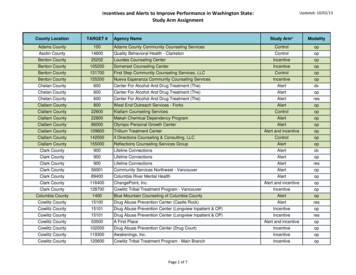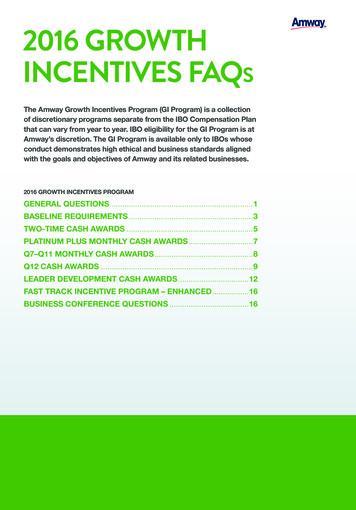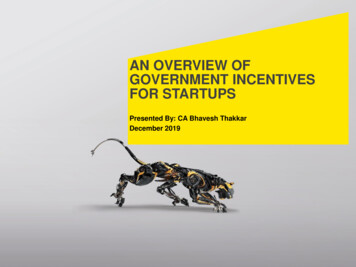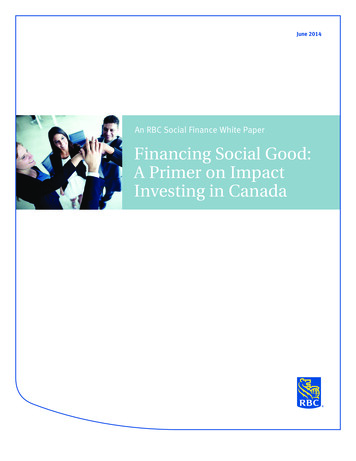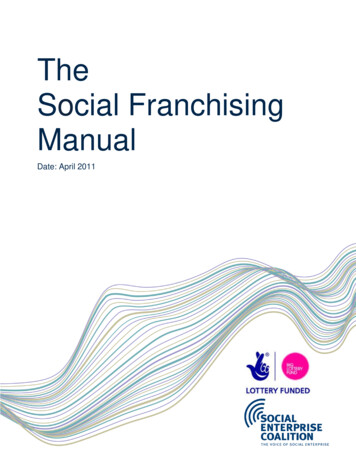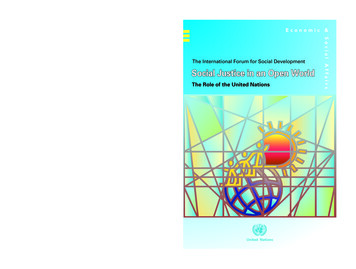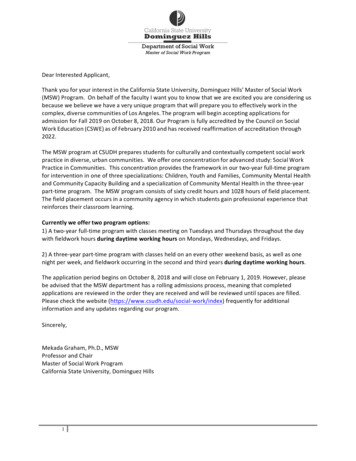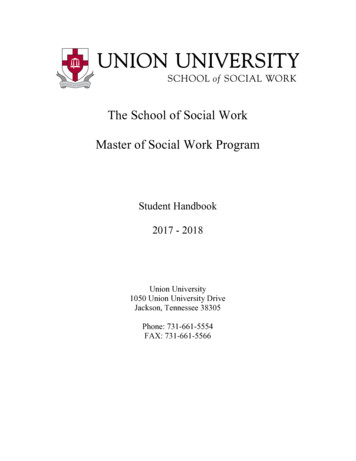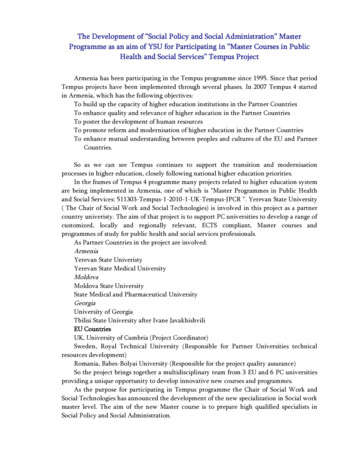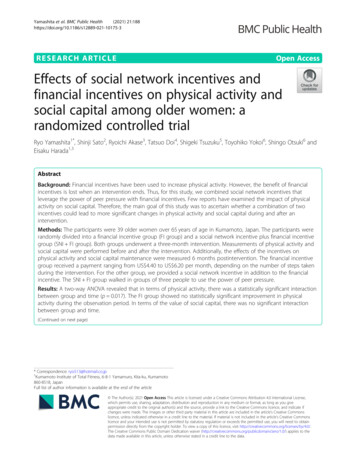
Transcription
Yamashita et al. BMC Public Health(2021) SEARCH ARTICLEOpen AccessEffects of social network incentives andfinancial incentives on physical activity andsocial capital among older women: arandomized controlled trialRyo Yamashita1*, Shinji Sato2, Ryoichi Akase3, Tatsuo Doi4, Shigeki Tsuzuku5, Toyohiko Yokoi6, Shingo Otsuki6 andEisaku Harada1,3AbstractBackground: Financial incentives have been used to increase physical activity. However, the benefit of financialincentives is lost when an intervention ends. Thus, for this study, we combined social network incentives thatleverage the power of peer pressure with financial incentives. Few reports have examined the impact of physicalactivity on social capital. Therefore, the main goal of this study was to ascertain whether a combination of twoincentives could lead to more significant changes in physical activity and social capital during and after anintervention.Methods: The participants were 39 older women over 65 years of age in Kumamoto, Japan. The participants wererandomly divided into a financial incentive group (FI group) and a social network incentive plus financial incentivegroup (SNI FI group). Both groups underwent a three-month intervention. Measurements of physical activity andsocial capital were performed before and after the intervention. Additionally, the effects of the incentives onphysical activity and social capital maintenance were measured 6 months postintervention. The financial incentivegroup received a payment ranging from US 4.40 to US 6.20 per month, depending on the number of steps takenduring the intervention. For the other group, we provided a social network incentive in addition to the financialincentive. The SNI FI group walked in groups of three people to use the power of peer pressure.Results: A two-way ANOVA revealed that in terms of physical activity, there was a statistically significant interactionbetween group and time (p 0.017). The FI group showed no statistically significant improvement in physicalactivity during the observation period. In terms of the value of social capital, there was no significant interactionbetween group and time.(Continued on next page)* Correspondence: ryo513@hotmail.co.jp1Kumamoto Institute of Total Fitness, 6-8-1 Yamamuro, Kita-ku, Kumamoto860-8518, JapanFull list of author information is available at the end of the article The Author(s). 2021 Open Access This article is licensed under a Creative Commons Attribution 4.0 International License,which permits use, sharing, adaptation, distribution and reproduction in any medium or format, as long as you giveappropriate credit to the original author(s) and the source, provide a link to the Creative Commons licence, and indicate ifchanges were made. The images or other third party material in this article are included in the article's Creative Commonslicence, unless indicated otherwise in a credit line to the material. If material is not included in the article's Creative Commonslicence and your intended use is not permitted by statutory regulation or exceeds the permitted use, you will need to obtainpermission directly from the copyright holder. To view a copy of this licence, visit http://creativecommons.org/licenses/by/4.0/.The Creative Commons Public Domain Dedication waiver ) applies to thedata made available in this article, unless otherwise stated in a credit line to the data.
Yamashita et al. BMC Public Health(2021) 21:188Page 2 of 7(Continued from previous page)Conclusion: Our results suggest that social network incentives, in combination with financial incentives, are moreeffective for promoting physical activity than financial incentives alone among older women and that these effectscan continue after an intervention. In the meantime, further studies should be conducted on the effect of physicalactivity on social capital.Trial registration: UMIN000038080, registered on 09/22/2019 (Retrospectively registered).Keywords: Older women, Social network incentive, Financial incentive, Physical activity, Social capitalBackgroundIt is common knowledge that an increase in physical activity improves health. It reduces the risk of mortalityand cardiovascular diseases [1–4], improves physicalfunction [5], and improves quality of life [6, 7]. Additionally, the preventive effects of cognitive impairment[8, 9], depression [10, 11], and cancer [12, 13] have beenreported recently. Despite these beneficial effects, thelevel of physical activity is still low among the population [14, 15].Previous studies have shown that financial incentiveshave been used to achieve behavioral change in physicalactivity in an effort to solve this problem [16, 17]. However, the benefit of the incentive is lost when the intervention ends [18, 19], meaning that the effect offinancial incentives is short-term. Therefore, in thisstudy, we focused on social network incentives that leverage the power of peer pressure to regulate behavior[20]. An advanced study by Aharony et al. [21] divided108 active young people into three groups: i) a controlgroup, ii) a peer-view group, and iii) a peer-rewardgroup; participants were rewarded according to their increase in physical activity. In the control group, individuals were rewarded for their own increased physicalactivity [21]. In the peer-view group, the participant wasshown his/her buddies’ activity levels, but was stillrewarded for his/her own activity level. In the peerreward group, the buddies received a reward proportional to the participant’s activity level. As a result, thepeer-reward group yielded a significantly larger increasein activity level than both the control and peer-viewgroups. In their study, creating peer pressure by addingtwo “buddies” to one person was necessary to achievethis benefit. Aharony et al. called this strategy “socialnetwork incentives.” Furthermore, their study found thatincreased physical activity continues after the intervention has ended when financial incentives are combinedwith social network incentives. Therefore, combining social network incentives with financial incentives for increased physical activity may have a long-term effect.However, the participants in Aharony et al.’s study onlyincluded young people. In addition, their study did notexplicitly present a randomized controlled trial. Thus,we hypothesized that the combination of social networkincentives and financial incentives would have a longterm effect on physical activity in older persons, and decided to verify this using a randomized controlled trial.Furthermore, Brach et al.’s [22] study demonstratedthat physical activity plays a significant role in maintaining functional fitness in older women [22]. Additionally,a decrease in muscle strength and mass is likely to be aconsequence of more physical inactivity. Therefore, it isimportant that older women increase their physical activity [23].On the other hand, recent public health research revealed that individual health behavior was affected by social capital [24, 25]. This mechanism works in such away that being integrated into a particular networkmeans that people are under the influence of others inthe same network, and as a result their individual healthbehavior is controlled [26]. Meanwhile, there have beenno previous findings which showed that physical activityenhances individual-level social capital. Therefore, weassumed that encouraging walking in small groups usingsocial network incentives should enhance individuallevel social capital.The main goal of this study was to ascertain whethercombining financial incentives with social network incentives could lead to more significant changes in physical activity and social capital among older womencompared to financial incentives alone, during and afteran intervention.MethodsStudy design and participantsThis study was a randomized study in which participantswere recruited by handing out leaflets in several differentregions in Kumamoto, Japan. Forty-four older womenover 65 years of age were recruited between August2017 and September 2017.After completing measurements before the intervention, participants drew a sealed envelope to determinewhether they were allocated to the financial incentivegroup (FI group) or the FI plus social network incentivegroup (SNI FI group).During the intervention, two participants in the FIgroup and three in the SNI FI group dropped out.Eventually, the study groups comprised 21 participants
Yamashita et al. BMC Public Health(2021) 21:188in the FI group and 18 participants in the SNI FIgroup. The study flowchart is presented in Fig. 1.Each participant in the FI group received a paymentranging from US 4.40 to US 6.20 per month, dependingon the number of steps taken per day during the intervention as follows:(a) A 4.40 gift card if the average daily steps for amonth was between 5000 and 7999 steps/day.(b) A 6.20 gift card if the average daily steps for amonth were 8000 steps/day or more.The SNI FI group participants walked in groups ofthree people to utilize the power of peer pressure, inaddition to receiving the financial incentive. Threepeople from the SNI FI group selected the groups inthe order in which they opened the envelopes, aftergrouping by randomization. Consequently, most groupsdid not know each other in advance. The groups of buddies remained the same over the three-month intervention in this study. The participants were informed thatthey would walk in groups of three people about once aweek. Furthermore, their rewards were designed to reflect the largest number of steps taken among their“buddies.” The buddy’s overall step count results werecommunicated between themselves as they walked together. In addition, regarding the reflected rewards, thenumber of steps taken by all group members, thereflected number of steps taken, and their rewards weredelivered to each group member once a month. Thepayment rewards ranged from US 4.40 to US 6.20 permonth and were available for both groups. After thethree-month intervention, the participants were notasked to walk with their peers. However, they couldPage 3 of 7decide for themselves whether to walk or not. In theSNI FI group, if it became impossible even one in threepeople to walk together for whatever reason, the research was excluded.Both groups underwent a three-month interventionbetween September 2017 and December 2017. Beforethe intervention, each group was assessed for age, bodyheight, body weight, body mass index, and percentage ofbody fat. Measurements of physical activity and socialcapital were performed before and after each intervention. Additionally, the effects of the incentives on activitymaintenance were measured 6 months after the intervention. The study design described above has followedthe one in our previous study [27].All participants provided written informed consent toparticipate in the study, which was approved by the ethics committee of Osaka Sangyo University (2017-JINRIN-016).BlindingThose assessing the outcomes were blinded to thegrouping allocation; however, owing to the nature of theintervention, participants were not blind to their allocation. The FI group participants did not know about theSNI FI group reward structure.Anthropometric measuresBody height was measured to the nearest 0.1 cm. Bodyweight was measured to the nearest 0.1 kg using a digitalscale. Body mass index (BMI) was calculated using theformula BMI body mass (kg)/ (body height [m])2. Thepercentage of body fat was calculated using the formula:Fig. 1 Flow diagram of the two groups’ progress through the phases the randomized trial
Yamashita et al. BMC Public Health(2021) 21:188adult body fat% (1.20 BMI) (0.23 age) – (10.8 sex)-5.4 [28].Physical activityBefore starting the study, a pedometer (EX-500,YAMASA TOKEI KEIKI CO., LTD, Tokyo, Japan)was given to each participant to measure the numberof steps per day. Each participant also received adiary to record their daily step count (pedometer).The SNI FI group kept record in the diary whenthree people walked together. For the evaluation ofthe number of steps, the average daily step count for1 month was calculated based on the number of stepswritten in the diary. To manage the accuracy of thetotal number of steps, researchers collated the pedometer’s weekly data when participants submittedtheir diaries.Social capitalThe measurement of social capital used trust, network,and social participation by referring to Yang’s report[29]. Trust and network of social capital was surveyedusing a questionnaire created by the Japanese CabinetOffice. The trust was assessed by a single item: “Generally speaking, would you think that most people can betrusted?” The responses were selected using a Likertscale [30]. The network used two questions. The firstquestion was regarding “Relationship with neighbors.”This question included a four-point scale (none; wouldgreet; would talk while standing; would consult with lifeconcerns). The second question concerned the “Numberof neighbors with whom one has a relationship.” Thiswas also a four-point scale with the following possibleanswers: zero, four or fewer people, five to nineteenpeople, and twenty people or more.From a previous study by the Japan Science andTechnology Agency Index of Competence (JST-IC),the social participation was assessed using four items[31, 32]. The four items were as follows: (1) Participate in regional events; (2) Participate in aPage 4 of 7neighborhood association; (3) Assume a managerialposition or role such as the leader in a residents’ association; and (4) Engage in charity. These items wereassessed using Yes 1/No 2, and the points weresummed. All these measurements were of undefinedtime frame.For social capital, individual indexes were calculatedby standardizing (calculated so that the mean was “0”and the standard deviation and variance were “1”) each
social network incentives should enhance individual-level social capital. The main goal of this study was to ascertain whether combining financial incentives with social network in-centives could lead to more significant changes in phys-ical activity and social capital among older women compared to financial incentives alone, during and after
